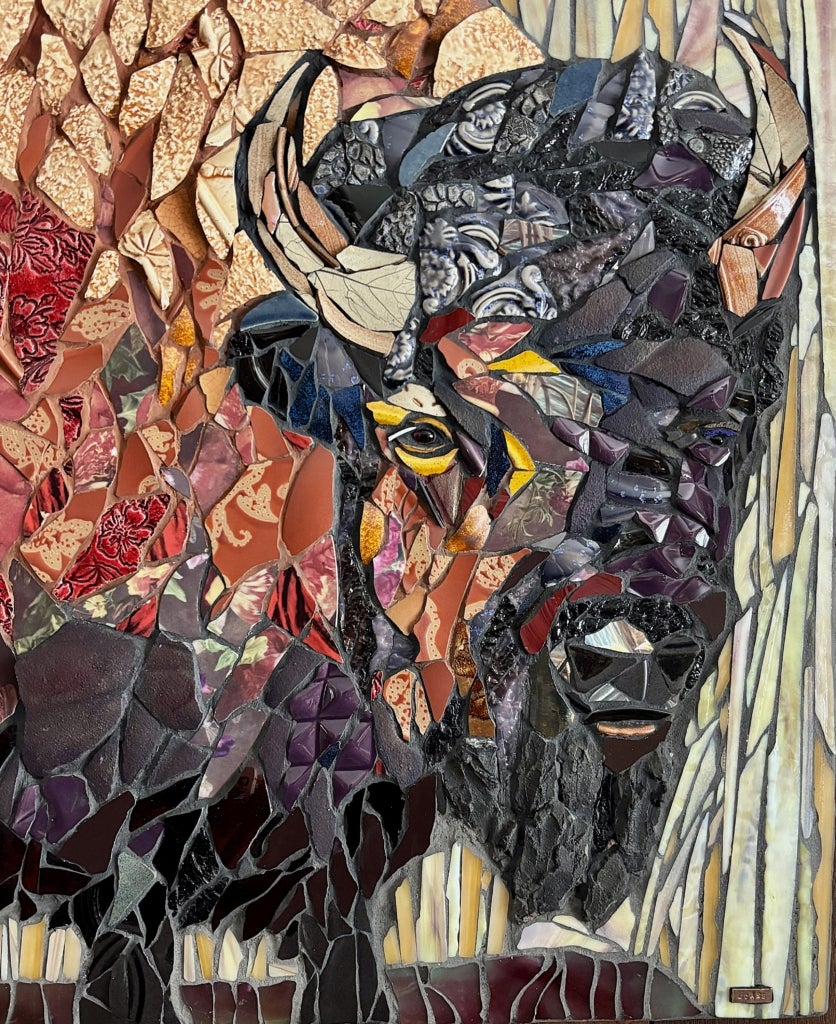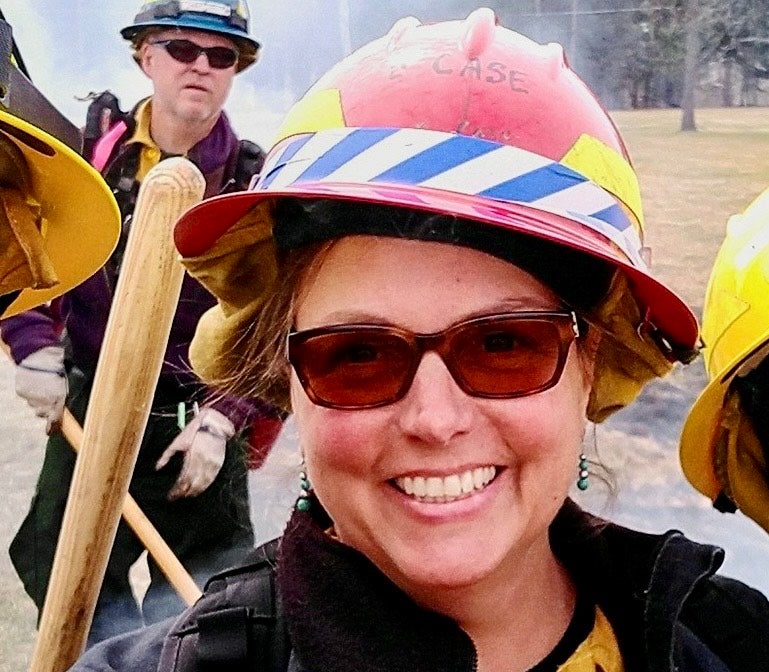This Artist’s Mosaic Pieces Together the History of Bison and Their Ongoing Role in US Land Management
Bison once freely roamed grasslands and prairies from Mexico to Alaska. Herds of several thousand traipsed patterns into the landscape, the weight and scuff of their hooves, their grazing behavior, and the nutrients of their dung all taking, coaxing, and replenishing health and balance across ecosystems. Beginning in the 1800s, hunters began to deplete these herds. By the middle of the century, bison were nearly extinct. Some reports estimate as few as 300 survived an era of unregulated massacre. Today, collaborative efforts between landowners, conservationists, and governments have husbanded the creatures back up to a healthy number, with over 300,000 bison now populating the American West. While these herds are largely managed as livestock and do not have the freedom or range of their wild ancestors, these managed flocks offer myriad ecological benefits.
Bison demand respect from human passersby. Rarely do they turn to meet the gaze of gaping tourists, preferring, instead, to remind them of their precedence over the now shared space by keeping their distance. It is this aura of belonging on the land that inspired artist Jennifer Case’s recent mosaic Creative Spirit.

Proximity to land fuels Case’s creativity
Case was road-tripping across Nebraska in 2023 to deliver a commissioned artwork to the Glacier Creek Preserve outside Omaha when the spark was lit.
Across the several-day trip, she had multiple close encounters with bison, and each was powerful. “Seeing them in their native habitat left a lasting impression on me,” said Case.
Case is a multimedia artist specializing in mosaics. She first discovered the medium while experimenting with a piece depicting a cutthroat trout. It was her first attempt at using broken dishes and pottery to create something new. “I fell in love with how dimensional you could make them due to the curve of the dishes,” she said. The cutthroat trout curves off the body of the piece, adding a sense of movement. “I’ll never sell this one because he reminds me of having my creative world blown wide open – realizing all materials were on the table, recycled plates, scrap metal, shells, rocks, etc…, was monumental.”
The natural world has always inspired Case’s work. “I’ve never considered doing anything other than natural subjects,” she said. “I will get a particular animal/subject stuck in my head and spend a lot of time thinking about it until it eventually ends up on my bench as a piece of art.”
Over two decades in land management forged intimacy between Case and her subjects
Until last year, nearly every waking moment of Case’s days were spent on the land, carefully negotiating with stressed habitats. During her 26-year career at The Nature Conservancy (TNC) she worked mostly in fire management, first as a prescribed fire burn boss and then as fire manager for TNC’s Pennsylvania and Delaware chapter. It meant rising early and staying late, her days bookmarked by the rise and fall of a distant fire.
Long before TNC began its work across the country, bison played an important role in fire management. In the wake of wildfire, these creatures promote ecological regeneration. Grasses are the first flora to venture forth from a singed landscape. They are also bison’s preferred snack, enticing herds to the burned area where they can graze without the distraction of less tasty plants. Their activity helps ensure diverse regrowth of the region.

Bison have inspired and sustained people for hundreds of years
Case also noted the importance bison play in some Indigenous cultures. For Tribes including the Northern Cheyenne, Arapaho, and Lakota, bison were both sacred figures and important sources of food, clothing, tools, and shelter material. Their role as ecosystem directors, prompting natural cycles to play out, mirrored the values of these cultures that live(d) deeply entwined with land. Similarly, bison’s erasure in the 19th century coincided with, and itself constituted, attacks on Indigenous people across the nation.
“I am not Indigenous, but their cultures, views on the environment, sustainable living practices, lessons from Mother Earth, and beautiful art resonate deeply with me,” said Case.
Recent years have seen myriad initiatives to return bison to ancestral grazing lands across the United States. These include a collaboration between the InterTribal Buffalo Council, Tanka Fund, and TNC that brought over 2,300 bison to preserves stretching from Indiana to Colorado and North Dakota to Oklahoma between 2020 and 2025. TNC wrote that this work is both critical to reparations between the US government and Indigenous Peoples, and to these lands’ ecological and climate resiliency.
Entering a new stage of life allows Case to connect anew with natural wonder
Retirement has brought Case new and different opportunities to explore nature. She has more time to dedicate to art and leaned into telling the stories of the land through her work. “I see this next chapter as one where I can let my creative spirit show up, take up space, and guide me,” she said.
This feeling is behind the name of her mosaic Creative Spirit. She had initially planned to depict a bison herd, but as she got started, she moved naturally in a different direction. She has learned to let her “internal muse” take over. “If you fight it, the piece suffers, and so do you because it doesn’t flow.”
The boldness of the end result—a close-up “portrait” of a single bison’s head and torso—resonated with her. “My Bison unapologetically takes up this space. I love the representation of a large, free-roaming spirit, a keystone in its native environment.”
The relationship between artist and environment is different, perhaps gentler, than the relationship practitioners forge when they dig their hands into the soil, cut away branches, plant, and reap, and burn, but it plays its own role in environmental outcomes. “Art evokes emotion, starts a conversation, and raises awareness in ways other methods can’t,” said Case. “The whole purpose of art is to make you feel something. Feeling something is the first step to caring about it.”
More About the Artist
Jennifer Case is a Pennsylvania-based mixed media artist. Since she was a child, creativity and curiosity flowed through her. She loves to draw, collect found items, and admire moments in nature. She retired from a career in fire management in 2024 and is now driven to rise in the morning, and kept awake at night, by her desire to create. You can see more of her work online at Ochre Mill Studios and follow her on Instagram @jlcase0000.
Photo: Case (foreground) and her husband (back left) work as burn bosses. Courtesy: Jennifer Case.

Have news? Share updates from your organization or country by emailing ilcn@lincolninst.edu.
